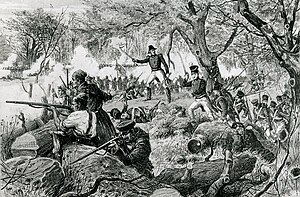Battle of the Chateauguay
| Battle of the Chateauguay | |||||||
|---|---|---|---|---|---|---|---|
| Part of the War of 1812 | |||||||
 Bataille de la Chateauguay by Henri Julien. Lithograph from Le Journal de Dimanche, 1884. |
|||||||
|
|||||||
| Belligerents | |||||||
|
Mohawk Nation |
|
||||||
| Commanders and leaders | |||||||
|
|
|
||||||
| Strength | |||||||
| 50 fencibles 400 volunteers 900 militia 180 Mohawks |
2,600 regulars 1,400 militia |
||||||
| Casualties and losses | |||||||
| 2 dead 16 wounded 4 missing |
23 dead |
||||||
| Official name | Battle of the Châteauguay National Historic Site of Canada | ||||||
| Designated | 1920 | ||||||
23 dead
33 wounded
29 missing
The Battle of the Chateauguay was an engagement of the War of 1812. On 26 October 1813, a British force consisting of 1,630 regulars, volunteers and militia from Lower Canada and Mohawk warriors, commanded by Charles de Salaberry, repelled an American force of about 4,000, including 2,600 regulars, attempting to invade Lower Canada and ultimately attack Montreal.
The Battle of the Chateauguay was one of the two battles (the other being the Battle of Crysler's Farm) which caused the Americans to abandon the Saint Lawrence Campaign, their major strategic effort in the autumn of 1813.
Late in 1813, United States Secretary of War John Armstrong devised a plan to capture Montreal, which might have led to the conquest of all Upper Canada. Two divisions were involved. One would descend the St. Lawrence River from Sackett's Harbor on Lake Ontario, while the other would advance north from Plattsburgh on Lake Champlain. The two divisions would unite in front of the city for the final assault.
The Americans around Lake Champlain were led by Major General Wade Hampton, who had taken command on 4 July 1813. Hampton had several misgivings about the plan. His own troops, encamped at Burlington, Vermont, were raw and badly trained, and his junior officers themselves lacked training and experience. There were insufficient supplies at his forward base at Plattsburgh as the British had controlled the lake since 3 June. On that day, two American sloops pursued British gunboats into the Richelieu River and were forced to surrender after the wind dropped and they were trapped by gunboats and artillery firing from the river banks. The British had taken over the sloops and used them in a raid against many settlements around Lake Champlain. In particular, they captured or destroyed quantities of supplies in and around Plattsburgh. Although the British crews and troops involved in the raid were subsequently returned to other duties, the American naval commander on the lake, Lieutenant Thomas Macdonough, was unable to construct a flotilla of sloops and gunboats to counter the British vessels until August.
...
Wikipedia
